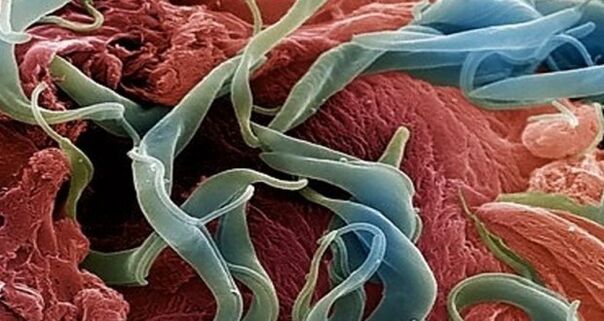
People and animals are attacked by these creatures, infection is easily transmitted to each other through infected products, water and dirty hands.The emergence of parasites in the body will help prevent prevention rules and meticulous respect for personal hygiene, but even these measures do not guarantee a hundred percent protection.Helminants living in the human body can live in various organs, differ in size, in size, as well as the degree of evil to a person.
Parasites in the human body
How many situations is there when a person walks in doctors for years and cannot get rid of allergies, treats asthma, sugar drugs and everything in vain?Each of us has such knowledge that has spent enormous quantities for the treatment of various diseases and have not obtained any results.
It is only in rare cases, when the doctor is either very intelligent or very responsible, he directs such a patient towards a regular analysis of the excrement, then ... then parasites are in the human body, which cause dozens of diseases, and with which no one is fighting in the treatment of these pathologies.
Unlike established opinion, worms are not necessarily "prescribed" in the intestines and can be detected by a banal analysis of the excrement.Many parasites feel good in the lungs, the heart, the muscles, even in the brain and the eyes.
Well -known malaria, which has been defeated, has returned again and it is the most dangerous parasitic disease in the opinion of experts.The malaria plasmodium lives exclusively in the blood and all doctors will not be able to recognize this disease with sufficient confidence.
How parasites fall into the human body
They fall into the human body in different ways, most often this is due to the use of water and infected food.
Grape eggs remain viability up to 6 months and through toys, carpets, underwear and pastel linen in the body.Askaride eggs come to us inside with poorly washed vegetables and fruits.The Maison Barbecue or Keyex barbecue is a 95% infection guarantee by trichinellosis.
The parasites penetrate in us with insect bites, during bath in the freshwater tanks, in the air, with dust, which is an child carrier.
Salted fish, stroganine or caviar are the cause of infection by adhesive tape worms, the length of which reaches 12 meters and which can live in your body under 25 years of age.Infants infection have become more frequent in parasites in the uterus.Dogs and cats, by their damp breathing, can dispel the eggs from parasites at a distance of up to 5 meters.
You can be infected with dirty hands, not only their own, but also sellers, cooks, servers, parasites travel on money and running hands.A high concentration of parasitic eggs is observed in products, such as: bacon, smoked sausage, ham, sausages, pork of all shapes, beef, chicken, lamb and even chicken eggs are very often infected with them.
Epidemiologists around the world try to fight this misfortune.In the United States, for example, for the verification of helminthias, 1 pork car in thousand is destroyed.This develops in losses of several million dosters, but otherwise it is impossible.
There are no absolutely reliable means to disinfect meat, and the ordinary culinary treatment of larvae does not destroy.You cannot guarantee the purity of your food by welding or frying meat, a large number of parasitic larvae always penetrate your body.
In which organs can a person live in parasites
Helminthic parasites are divided into two categories which correspond to the place of activity in the body of the donor:
- cramp: Worms living in various gastrointestinal cuts.There are about 100 varieties of intestinal parasites, and for each intestine department, there are a few dozen species.The small intestine is ready to take Ascaris, the Antilost, the wide ribbons and other less common "brothers".The small intestine "will share the living space" with politicians, a dwarf chain and the rest.The medical literature describes cases when a person was infected with several types of parasites at the same time;
- Fabric:Worms located in the organs, the tissues and even in the blood.Modern medicine successfully succeeds in paragonimosis (lungs), cytycchosis (brain), echinococcosis (liver) and phyaririosis (lymphatic vessels).Some worms move in the body through the blood system and randomly attached to any organ.If many eggs have been introduced, the whole body can be infected.

Snoe - What they look like in the human body (Photo of Vers)
Speakers- It is one of the most common human parasites, which are a round worm (nematode).Most often, infection with pine steps occurs in children, but is also found in adults.
The pin is a white, small and round parasite.The individuals of women have dimensions: 8-13 mm in length, 0.5 mm thick, an oblong shape and a straight tail, pointed out at the end.
This characteristic of the tail of the female parasite explains its name - "cutter", of the word "Sharp".The male individual is much smaller: its length is 2 to 5 mm, the thickness is 0.2 mm, the tail is folded, unlike pine worms.
Human invasion has the name enterobiosis and occurs mainly with non-compliance with the rules of personal hygiene (insufficient wash of hands).Basically, pine worms live in the small section of the intestine and the upper part of the large intestine, but in some cases, they can also migrate to other organs and organ systems.

The female Helminthe, having fallen into the human body in an oral way, and mating with the male representative of the nematode, migrates in the thick department of the intestine, where it receives the nutrients necessary for the life and the maturation of the eggs of the non -digested food residues.
After 4 weeks, the female cutter begins to migrate into the rectum at a speed of 12 cm per hour, overturns from the anus and poses around 5,000 to 15,000 eggs in the perianal region, which after 4 to 6 hours is completely matured and ready for another life cycle.
This process can be accompanied by itching, which encourages an infected person to comb the anus, and thus contribute to the propagation of parasites, who fall into food under the nails, in the hands of other people (especially for children who are very closely in contact and do not always observe it of personal hygiene rules).
The infection with pine steps comes from a person to a person, through dust with parasitic eggs, objects that the patient has touched.Aspired eggs can also be transferred to food with cockroaches and flies.
In addition, the eggs remain on linen, clothes, beds, which explains their rapid distribution.Due to the fact that the life cycle of the worm is very ephemeral and that the infection comes from a person to a person, it is quite difficult to get rid of parasites, because in addition to taking Anthelminthes drugs, the personal effects of the patient are necessary and its insulation from other nematode environments.
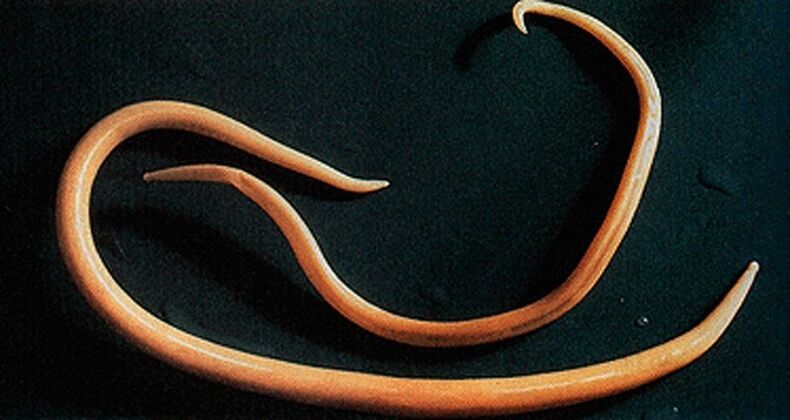
ASKARIDS - What they look like in the human body (Photo of worms)
Askarida-It is a large parasite of a spindle shape of a red yellow color, reaching an adult condition of 40 cm (female) and 15-25 cm (males).Without a taster or other fixing devices, the ascaride can move independently to the food masses.The eggs deposited by the female parasite are distinguished with excrement.
Acaderosis infection occurs in case of mature egg tasting with water or unwashed vegetables and fruits on which there are soil particles.After the eggs penetrated the intestines, the ripe larvae come out of it.
Then, introducing into the intestinal wall, they reach the heart according to the blood circulation, and from there, they fall into the lungs.Through the pulmonary cells, the Asscarida larva through the respiratory tract enters the oral cavity again.
In the intestinal phase of their existence, ascarids with the capacity of spiral movements can penetrate even the narrowest holes.This characteristic of the parasite often leads to the development of fairly serious complications (mechanical or pancreatitis)
After swallowing repeated, the parasite reaches the small intestine, where it turns into an adult.The worm lives for 12 months, then dies and stands out with excrement.In the intestines of an owner, an owner can live one or more hundred people.
Allergens secreted by ascarids can cause serious allergic reactions.A large number of adults can cause intestinal obstruction, and the worms that have penetrated the airways sometimes cause suffocation.

Vlasovsov - What they look like in the human body
BlacovyvThey often live in the southern regions, because the eggs of this worm love heat.Most infections are observed in rural areas.Vlass -head eggs live in the ground.
Invasia occurs in the hands, polluted particles of the earth, vegetables and poorly washed fruits.Following an infection, an illness occurs - trichocephalosis.Vlashev parasitic in the intestines.This worm causes anemia, because it feeds on human blood and severe abdominal pain.
For the diagnosis of trichocephalosis, the rectum and the Sigmoid intestine are examined with a special device (rectoroscopy).Thus, accumulations of parasites in the intestines are found.The treatment of the invasion is long because the wounds are protected by a thick shell.
Parasite eggs are distinguished with excrement, but they are very small, they cannot always be seen even under the microscope.It is only with a very strong invasion that it is possible to detect eggs in the analysis of the excrement.In shape, they look like a barrel, have a brownish yellow color.
On 2 sides, the eggs are holes.What do worms look like in the excrement?It is very difficult to find them alive in the stool, because the Blazoles cannot live long outside the human body.It is only with Anthelminthes therapy that we can see in the excrement of worms without dead end of the white color.
Hepatic bacon - what it looks like in the human body
A parasite causing the opisthorchiasis is a flat worm reaching a length of 7 to 20 mm.
In the acute phase of helminthiasis, the patient has pain at the top of the abdomen, body temperature increases, nausea, muscle pain develops, diarrhea and rashes are possible.The parasitic larvae begin to develop after the eggs fall into fresh water (swallowed snails).Then they enter the body of the fish (carp, carp crucian, bream, roach).
Human infection occurs when you eat infected fish meat that has not suffered sufficient heat treatment.The hepatic bomb larva of the small intestine enters the bile ducts and the gallbladder, fixing with two suction cups.
The chronic course of the opisthorchase is manifested by the symptoms of hepatitis, the inflammation of the bile ducts, cholecystitis, altered digestive tract, nervous disorders, weakness and increased fatigue.The parasite is a motivation towards the development of irreversible changes, and even after his expulsion, the patient does not transmit chronic inflammatory processes and functional disorders.

Trichinella - What looks like in the human body (Photo of worms)
The causal agent of trichinellosis is a small round helminthe which reaches 2 to 5 mm in length.The infection occurs when the use of bad fried meat (pork, cubs bear, wild boar).Entering the intestines, the parasitic larva in 3 to 4 days matures to the state of the sexually mature individual.
The life expectancy of the worm is 40 days, after which the parasite dies.By driving the intestinal wall, the larvae enter the blood circulation and are transported in all the organs of the human body, settling in the muscles.In this case, the respiratory and facial muscles, as well as the members' ado muscles, are most often affected.
In the first days following the invasion, patients complain of abdominal pain.
Then, after about 2 weeks, the body temperature increases to 39-40 s, the itching appear on the skin, the muscle pain develops and the face swells.
During this period, in the case of a massive infection, there is a significant risk of death.After about a month, recovery occurs.The parasite is encapsulated in a spiral form, after which he died in two years.
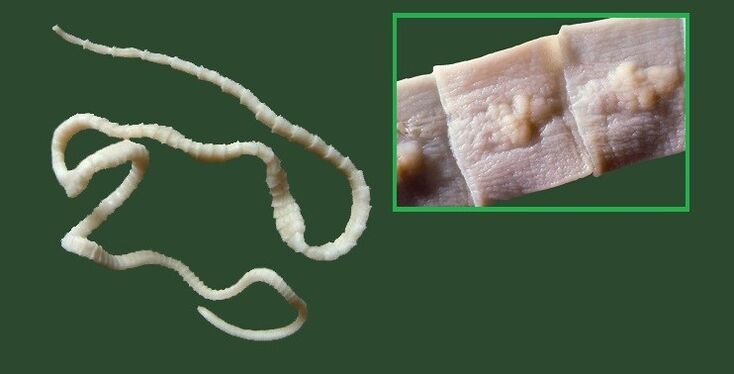
Large ribbon - What it looks like in the human body
It is one of the largest helminths reaching a length of 10 to 20 meters.The disease caused by this parasite is called dipillobotriosis.The development cycle of worms begins with freshwater fish or crustaceans.
Reaching the small intestine, the parasite is attached to its wall and for 20-25 days reached a sexually mature individual.
The larva enters the human body, which is the last owner of a large ribbon with caviar or infected fish net.
Difillobotriosis takes place in the context of the disorders of the digestive tract and anemia B12-Canion.
Echinococcus - What it looks like in a person's body
For this parasite, a person is an intermediate host.The parasitic worm in the human body in the form of Finnish.The last owner of Echinococcus is a wolf, a dog or a cat.
The infection occurs food in contact with animals and environmental objects, with the handful of echinococcus eggs.After entering the intestines, the oncospheres (six black larvae) develop from them.From the intestine, they enter the blood circulation and are transported throughout the body.
The "favorite" parasitization places are the liver and light.Installing in these organs, the larva turns into a finn (echinococcal cyst), which, gradually increasing, begins to destroy the tissues nearby.
Often echinococcosis in the diagnostic process is confused with a tumor of benign or malignant origin.In addition to mechanical exposure (subcontractors and blood vessels), a break in the echinococcal cyst sometimes occurs.This condition can cause toxic shock or the formation of several new cysts.

Alvéococcus - What it looks like in the human body
This parasite, which is considered a variety of echinococcus, is the cause of one of the most dangerous helminthias (alveococcosis), which is similar in gravity with cirrhosis and liver cancer.The infection occurs with the penetration of the oncosphere (eggs with mature larvae) into the intestines.
This parasite, considered as a variety of echinococcus, is the cause of one of the most dangerous helminthias (alveococcosis)
There, the embryo leaves the egg and, introducing into the intestinal walls, enters the blood circulation.In addition, with a blood flow, the parasite spreads through all the tissues and organs of the body (most often located in the liver).This is where the main phase of development begins at the larvae (a multi-chamber bubble, Laurelocyst) is formed).
Each room contains an embryo head of a parasite, which continues to develop gradually.Lavroists are very aggressive training that develops constantly due to increasing bubbles, and have the capacity to germinate in the liver, such as cancer metastases.
The nearby fabrics due to the alteration of the functioning of blood vessels are subject to necrotic changes.Opening the nearby structures, Alveokokk forms fibrous nodes with the inclusions of multi-chamber bubbles.This condition may last for several years, within the framework of which it requires compulsory surgery.
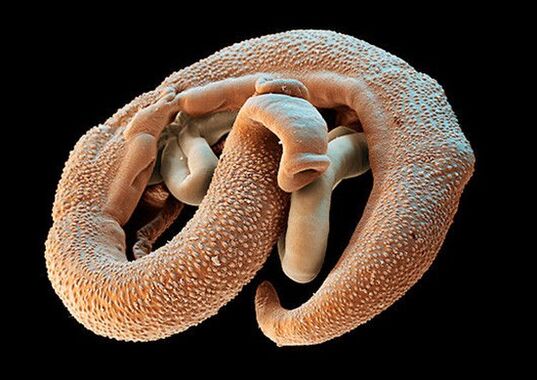
Schistosoma-What is it like in the human body
Schistosoma - A -A -AUCHERCH, belongs to the class of tremotodes, depending on the type causes various schistosomosis.It is a flat separate helminthe, reached 4 to 20 millimeters in length, 0.25 mm wide.The body of the schistosome is equipped with the second oral and abdominal subventy, they are located from each other.Schistos women are longer and thinner than men.There is a longitudinal groove on the male body, with it, it holds the female.Their eggs with a diameter of 0.1 mm, the oval shape, on the surface of one of the posts are a large peak.
The human verses of the schistosomes in the role of the final owner choose people, in their organisms which they parasitize in the small veins of the colon, the abdominal cavity, the uterus, the bladder.The worms feed on blood, partially absorb nutrients through the cuticle.Eggs with schistos are transported to the intestines and the bladder, where they ripen and stand out with excrement or urine.In freshwater water, a larva - Miucidius, its intermediate host - the molluscs come out of the eggs.In the body of the mollusc, the metacaria develops in curials in 4 to 8 weeks.
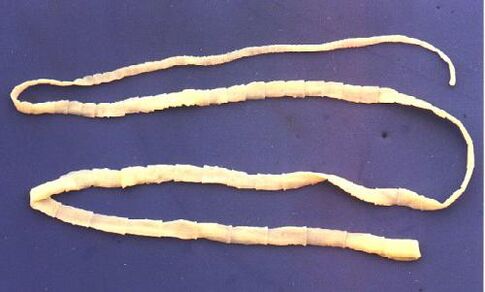
Pork shade-What is it like in the human body
The pork tenia, like the bull, on the body has 4 sub-shackles, but in addition to that, the body of the helminthe is also equipped with a double whip of hooks.Strogil reaches two to three meters in length.The pork tenia has a three ovarian, on each side, the uterus has 7 to 12 branches.A characteristic of this helminthe is the ability of the segments to be released from the anus.After the exit outside, their shell becomes dry and the burst, then the offensive eggs enter the outside environment.The intermediary master of Ténia can be pigs and a person.
The main owner is a person.Intestinal parasites in humans include pork tenine, helminthe is located in the patient's intestines, where he lays his eggs.Infection occurs when invasive meat is used.
Which doctor contact with the verses to contact
If an infection by worms is suspected, it is necessary to consult a specialist in infectious diseases, helmitologist Or a parasitologist.You can contact a specialist in infectious diseases regarding infection by parasites or protozoa.
Or a parasitologist.You can contact a specialist in infectious diseases regarding infection by parasites or protozoa.
You can only contact a Helmintologist if the infection is suspected precisely by parasitic worms (pine lines, ascarids, feathers, opisthorchiasis, etc.).
You can contact a parasitologist in cases where protozoa infection is suspected - Lamblia, toxoplasmes and amoebas.
In addition, if the parasite is not located not in the light of the intestines or the stomach, but in other organs (for example, the lungs, the liver), you can contact a specialist which is engaged in the diagnosis and the treatment of diseases of this organ.That is to say, for example, with the opisthorchiase, you can also contact a gastroenterologist or a hepatologist, and with echinococosis to a pulmonologist.


















